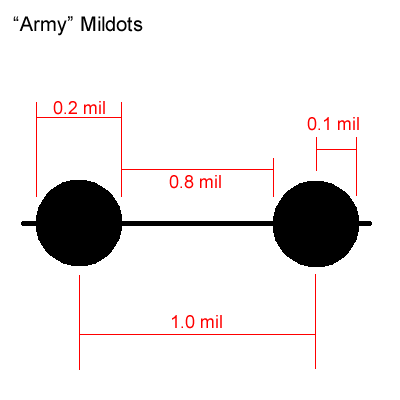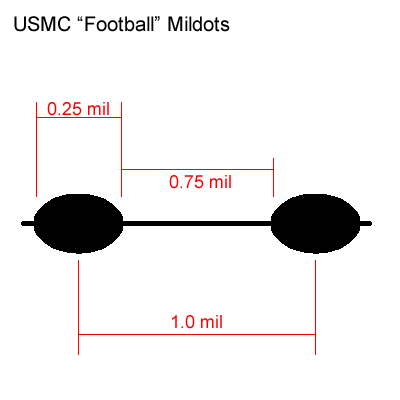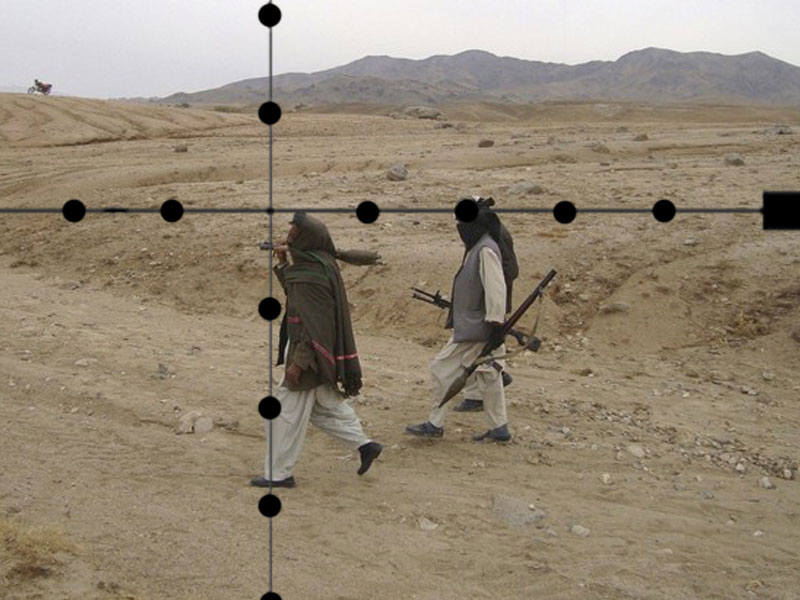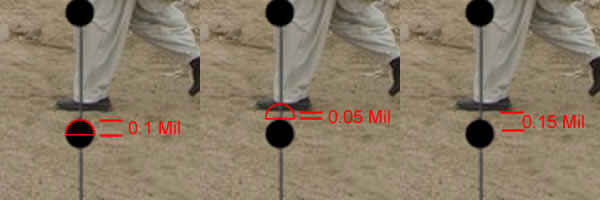
Ads are chosen by Google and not necessarily endorsed by this website.
 |
|||||||
|
|||||||
Mildot Range Estimation |
||||||||||||||||||
Range estimation is a key skill in the sniper's toolbox. If you don't know how far away your target is, you have little chance of hitting it on the first shot. One shot, one kill...right? There are many methods of locating the target's range. For the purpose of this period of instruction we will be covering range estimation with the mildot reticle and it's variants. In years past the basic mildot reticle came in two flavors. You could either get round dots or "footballs". In recent times the footballs have faded from existence. They have been replaced by a myriad of lines and circles and dots. The basic premise that we are going to demonstrate here will work for any milradian based reticle.
|
||||||||||||||||||
| Mil Relation Formula | ||||||||||||||||||
The core of rifle scope range estimation is a math problem referred to as the "Mil Relation Formula". This takes the height of the target in inches, multiplies it by a constant and then divides by the number of mils read in the scope. The basic formula looks like this:
The 27.77 is a "constant". This is sometimes expressed at 27.78, which is the mathematically correct rounded number. Most Marines will use 27.77 because that is what we were taught. Either will get you close enough to make a first round hit. Other formulas are available to convert range to meters or to start with the target height in a different unit of measure. I prefer this formula because it is easy to remember and uses units that most of us in the United States are familiar with.
|
||||||||||||||||||
| Measuring with Mils | ||||||||||||||||||
The hardest part of range estimation by the Mil Relation Formula is actually measuring the target. To be accurate you need to train your eye to measure to the nearest tenth or a mil or 0.1 mil. Most experienced snipers can measure down to five hundredths of a mil or 0.05. All it takes is practice. First Focal Plane vs. Second Focal Plane: Rifle scopes generally come in two varieties. The most common is the Second Focal Plane reticle. In this type the reticle covers more or less of the target depending on the magnification setting of the scope. If you are looking at a target through the rifle scope and you turn the power selector ring the reticle will appear to stay the same size as the target zooms larger. This causes a couple of problems. The first being that the reticle will only be accurate for ranging at one power setting. The second is that the reticle will only be correct for holds at one power setting. First Focal Plane scopes have been gaining popularity in the US. They have the benefit of the reticle reading correctly at any power setting. When you look through the scope at a target and turn the power selector ring the reticle will appear to grow or shrink at the same rate as the target. The drawback to this is that the reticle thickness becomes a compromise. Too thick of a reticle will obscure too much of the target at high magnification. Too thin and it will become invisible at low power. The reticle also becomes easy to loose in the background on low power in low light unless it is illuminated. Verifying the Reticle Scale: Your first priority before using your Mil reticle is to verify that the scale reads correctly and at what power. This is a fairly simple exercise. First find a large piece of cardboard. Draw a vertical line on it with a heavy black marker. Using a very accurate ruler make horizontal hash marks across the vertical line every 3.6". Be careful with your measuring. Set your cardboard at 100 yards and line the center of your reticle up with the bottom most hash mark on the cardboard. Each mil mark in your scope should line up with each hash mark on your cardboard. If you are using a mildot type scope then the hash marks should bisect the dots. If you are using a line type reticle like the GAP reticle then the hash marks should line up with the full mil hashes in the reticle. What if it doesn't line up? If your scope is a Second Focal Plane scope, then experiment with different power settings until you find the one that matches up. When you do, take a silver sharpie and make a mark across the ring and the scope body so that you can quickly locate the correct setting in the field. If your scope is a First Focal Plane and you are sure that you measured correctly when laying our your board, then you need to contact the manufacturer for warranty service. Milling the Target. Hopefully your scope came with literature showing the scale of the different portions of your reticle. In any Mil based reticle the center to center distance of the most prominent marks should be one mil. All other measurements are up for grabs. Here are a couple of common reticles: |
||||||||||||||||||
  |
||||||||||||||||||
We will use the "Army" type Mildots for most of our examples. These are the most common and found in Leupold as well as many other makes of rifle scope. I am not aware of any new scopes using the USMC Mildot. I include them here on the odd chance someone comes across an old USMC scope. To range a target to a tenth of a mil we need to build a stable position just like if we were going to send a shot downrange. Any tremor is going to cause problems. Place the reticle over the target and count how many full mil increments there are. |
||||||||||||||||||
 |
||||||||||||||||||
| In the image above we see that the Taliban fighter is 4 mils tall. Since our S2 briefed us that this selected target is 5'8" (68") we can plug these figures into our formula. | ||||||||||||||||||
 |
||||||||||||||||||
68 inches tall times 27.77 (our constant) divided by the number of mils the target measured in the scope (4). Crank that through your calculator and you see that our target is 472 yards away. Now let's make this a little more difficult.
|
||||||||||||||||||
 |
||||||||||||||||||
In this image we can see that our innocent little friends are taking a stroll. Our loader is more than two and a half mils tall, but that's not going to cut it.
|
||||||||||||||||||
 |
||||||||||||||||||
If we look closely at where his foot falls above the third mill dot we can begin to break it down. With your minds eye, split that mildot in half. That half mildot measure 0.1 mil. Now you can't quite fit that half mildot between his foot and the top of the whole mildot, so we break it down again. This gives us 0.05 mil. Now add that to the "half" mildot and we get 0.15 mil between the center of the dot and the bottom of our jihadist's foot. If we subtract 0.15 mils from 1, we get 0.85 mils. Add back in the two mils above that and we get a measured height of 2.85 mils. Lets assume that our militant here is 64" tall (from our intel reports). Let's plug that into our formula.
|
||||||||||||||||||
 |
||||||||||||||||||
If we didn't go to the trouble of breaking it down and just rounded it to 3 mils we would have come up with 592.42 yards to target. In this case that would have resulted in an elevation error of about 12" with M118LR. Breaking the dot down to .05 will give you improved accuracy but is not required for closer range targets. When the target won't stand still, or you do not know the height of your target you can use objects nearby. In the city this is pretty easy. Out in the woods it's a bit more difficult. If you have several objects in your field of view, range the largest first. Larger targets will generally give you more accuracy. Ranging several targets and taking the average will also cut down your error. After time you may notice patterns to your errors. It's good to note these so that in the future you can take them into account. A laser rangefinder is an excellent tool to have to confirm your calculations when you are learning to read mils. If you are working with a spotter, both of you should do the calculations independently and then take the average. Mildot ranging is an excellent skill, but is only as accurate as you are. It is also slow and difficult to use on moving tagets. In this a laser rangefinder excells. However, batteries die and electronics fail. Backup skills are nice to have.
|
||||||||||||||||||
| Additional Formulas | ||||||||||||||||||
|
||||||||||||||||||
| Common Items | ||||||||||||||||||
|
All dimensions are approximate and should be verified by the user. When possible it is a good idea for you to actually go out to the areas you work and measure common items. If you find yourself frequently in the same housing projects, then measure some windows and doors. They may come in handy some night if your LRF dies.
|
||||||||||||||||||
| Other Reticles | ||||||||||||||||||
|
||||||||||||||||||